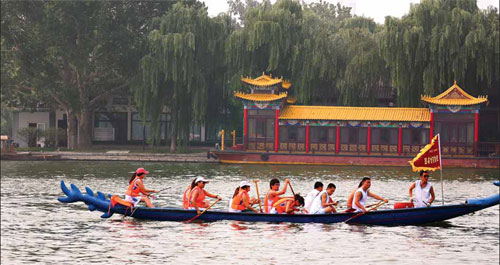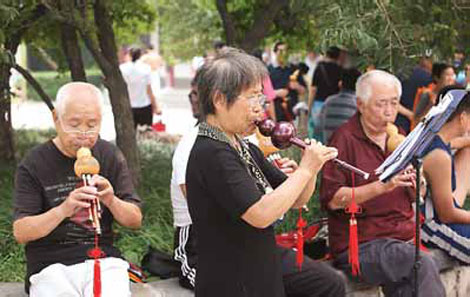Pleasures of Daming Lake
Updated: 2012-06-10 08:04
By Chitralekha Basu and Zhao Ruixue (China Daily)
|
||||||||
|
The annual boat race held at Daming Lake, a water mass created by the convergence of hundreds of springs.[Photos by Ju Chuanjiang / China Daily] |
|
Senior citizens find recreation at Baotu Spring Park. |
Behind Jinan's modern bustle, Chitralekha Basu and Zhao Ruixue find that lyrical scenes and traditions remain.
There is a face of Jinan that's dramatically different from the intense weave of high-rises, multi-tiered flyovers and glitzy storefronts that meets the eye at first. The flip side to this world of vehicles whizzing past and the hammering and scaffolding signifying continuous construction activity is not difficult to locate. The moat that once ran round the old city is still the focal area if you're looking for some of Jinan's most iconic landscapes - where the city's elderly and the very young like to gather.
It's a retreat for those who want to renew their bonds with nature, even as life speeds past them in one of China's fastest-growing manufacturing and technological hubs.
Our journey began at the south gate of Baotu Spring Park, where the most spectacular cluster from among Jinan's famed 72 springs might be found.
The springs in Jinan are a way of life here, especially for seasoned Jinan natives who come here early to chat or sing with pals.
They may take in a Shandong opera performance or two even as they keep an eye on their pint-sized grandchildren, cavorting merrily in the park, looking out for the lone seal in one of the ponds while shoals of goldfish swarm in the rest.
Nature has been generous with its gifts to China, and the amazing natural phenomena in this land have become a reference point for China's writers and artists. Baotu Spring Park is no exception.
For instance, a couplet written by Yuan Dynasty poet and calligrapher Zhao Mengfu (1254-1322) - "Mount Hua cannot be overcast by the clouds and fog/ The waves and the billows reach the Daming Lake" - appears at the Luoyuantang Temple, a two-tiered pagoda-roofed pavilion overlooking the water mass created by the three major springs in this park.
The springs, despite Jinan's low water levels, keep gushing forth and sending out ripples in concentric circles - the temperature a constant at 18 C all the year round - affirming the perennial renewal of the natural cycle.
Cangyuan Garden used to be the study of Ming Dynasty poet Li Panlong (1514-1570), and is still referred to by his nickname. It has since been turned into a gallery exhibiting the works of the master landscape painter Wang Xuetao (1903-1982).
Calligrapher and painter Guan Yousheng had carved the words "Shuyu Spring" on the low stone wall with handrails girdling the spring waters in the north, in 1956.
It was his homage to the Song Dynasty poet Li Qing-zhao (1084-1151) - who would, so the story goes, use the clear waters of the spring as a mirror while combing her lustrous tresses.
Easily the most feted among the poets and artists memorialized in Baotu Spring Park, Li has an entire pavilion dedicated to her, plus a series of tableaux comprising life-size wax models depicting her illustrious life.
Born into a noble family, Li was a child prodigy of sorts. Her artistic sensibilities were perfectly matched with that of the writer and statesman Zhao Mingcheng.
Duty kept Zhao away from home for long spells, inspiring Li to write some of her finest poems of love and longing, even as she watched her unkempt hair grow ruddier still, reflected in the spring waters.
It's fun stepping into the cheerful red and yellow covered boats from the north end of Baotu Spring Park.
The journey to Daming Lake, a water mass created by the convergence of hundreds of springs and sprawled out over 460,000 sq km, starts with adjusting the water level of the moat through manipulating the sluice gates.
As the boat goes down by about 3 meters, the sharp drop might be temporarily unsettling.
But soon enough the sight of the lush greenery on either side of the narrow canal, tiny waterfalls jumping into the stream and images of men fishing and children running around on the banks more than makes up for the initial jolt.
Sailing underneath an arched bridge, we reach the waters of the lake, almost without warning.
The green waters turn a colorless gray, lapping heavily against the 16-seater boat, which now feels really tiny. Far away in the horizon, a boundary of greenery cordons off the slew of high-rises.
We pass by a neat little island with trimmed hedges and rows and rows of weeping willows.
It's a part of the Daming Lake Park - where no one is allowed to go, except the men who have been keeping the garden and the pagoda-roofed pavilion on it all spic-and-span.
The boat drops us at the north-east gate of the lake. There are at least two noted temples - the Ming Dynasty (1368-1644) courtyard-style Tiexuan Temple and the Taoist Beiji Temple, originally built in the Yuan Dynasty (1271-1368) - across the road.
And then there are the art galleries, giant murals in Tianqiao Square, posh hotels with life-size sculptures lined up in the garden, a small geological museum and another one that used to be the Kuomintang headquarters around 1928, when the Kuomintang soldiers clashed with Japanese troops in the battle for Jinan.
Those running the roadside bookstores seem to be tipped, somewhat, in favor of the Kuomintang leader Chiang Kai-shek, whose army-gear clad figure appears on several prominent displayed titles.
But we prefer to walk back along the lake's north and north-western promenade rather than pop into any of these spots of tourist interest, taking our queue from the people, sitting around in lake-side benches or strolling leisurely, as they sip from their bottles of iced tea, or decide to get photographed in garish period costumes borrowed from a kiosk on a whim, giving in to a breezy afternoon of care-free indolence.
Contact the writers at sundayed@chinadaily.com.cn.


 'Taken 2' grabs movie box office crown
'Taken 2' grabs movie box office crown
 Rihanna's 'Diamonds' tops UK pop chart
Rihanna's 'Diamonds' tops UK pop chart
 Fans get look at vintage Rolling Stones
Fans get look at vintage Rolling Stones
 Celebrities attend Power of Women event
Celebrities attend Power of Women event
 Ang Lee breaks 'every rule' to make unlikely new Life of Pi film
Ang Lee breaks 'every rule' to make unlikely new Life of Pi film
 Rihanna almost thrown out of nightclub
Rihanna almost thrown out of nightclub
 'Dark Knight' wins weekend box office
'Dark Knight' wins weekend box office
 'Total Recall' stars gather in Beverly Hills
'Total Recall' stars gather in Beverly Hills
Most Viewed
Editor's Picks

|

|

|

|

|

|
Today's Top News
Health new priority for quake zone
Xi meets US top military officer
Japan's boats driven out of Diaoyu
China mulls online shopping legislation
Bird flu death toll rises to 22
Putin appoints new ambassador to China
Japanese ships blocked from Diaoyu Islands
Inspired by Guan, more Chinese pick up golf
US Weekly

|

|









